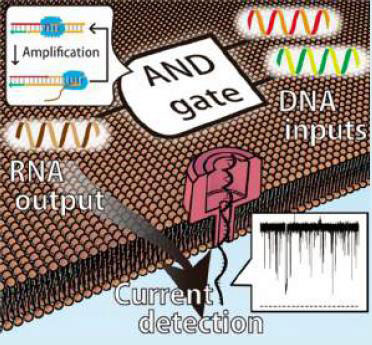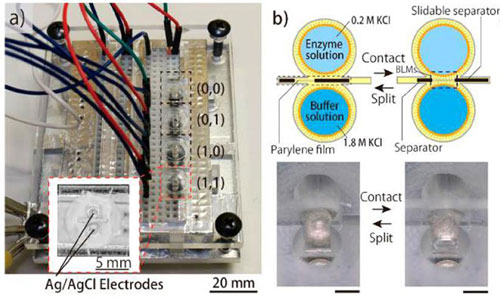| Posted: May 25, 2017 |
Successful use of DNA as a computer in artificial cells
(Nanowerk News) A group of Associate Professor Ryuji Kawano of Tokyo University of Agriculture and Technology, Division of Biotechnology and Life Science, Institute of Engineering, and Associate Professor Masahiro Takinoue of Tokyo Institute of Technology, School of Computing succeeded in detecting output molecules that are the calculation results of DNA computing using DNA molecules as electric information through a nanopore1 membrane protein (ACS Synthetic Biology, "Nanopore Logic Operation with DNA to RNA Transcription in a Droplet System").
|
 |
| DNA computing molecules are detected by nanopore proteins reconstituted in artificial cell membranes. Input DNA molecules were converted and output as RNA molecules, and then the RNA molecule information passing through the nanopore was extracted electrically.
|
|
Computers that we use everyday and engineering robots that incorporate these perform binary numerical calculation information processing using electrons as information media. On the other hand, molecular robots aim to perform information processing using binary numbers or more sophisticated computations using molecules (DNA/RNA) as information media.
|
|
In this research, they performed "AND" AND operation, which is a binary number, through DNA computing. We converted and output DNA as an input molecule to RNA and successfully detected the output RNA using electrochemical measurement via a nanopore. This makes it possible to retrieve output molecules as information in a shorter time than with conventional methods.
|
|
In addition, because it is possible to convert molecular information into electric information, the results lead to the integration of molecular robots and electronic devices.
|
 |
| Micro-device used for DNA computing and nanopore measurement. A droplet was created as an artificial cell membrane model in the device, and DNA computing and nanopore measurement were successfully performed at the same time in the droplet. (click on image to enlarge)
|
|
In the future, it is expected to be applied to systems that can diagnose and treat diseases in the body by constructing molecular robots with advanced functions.
|


